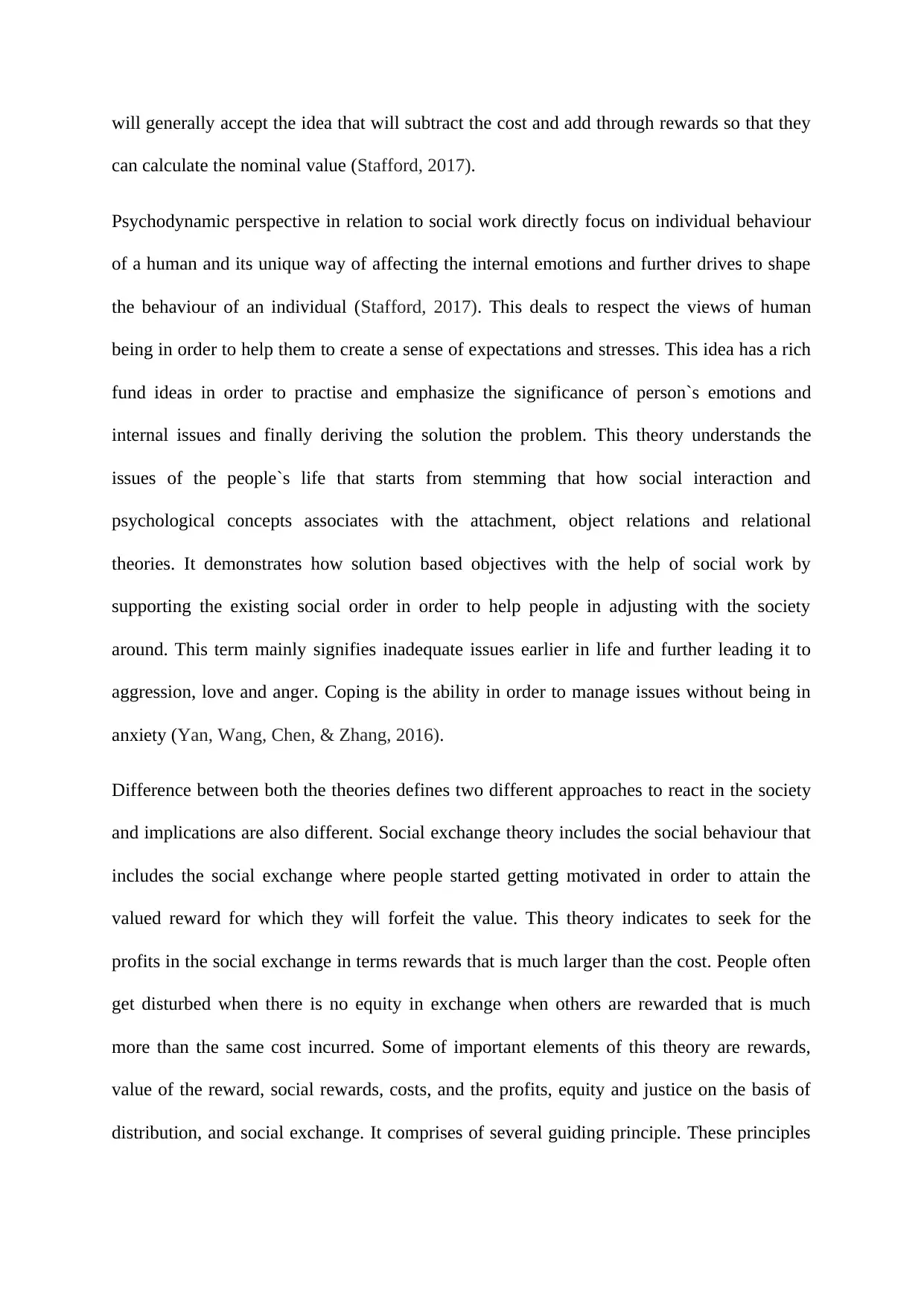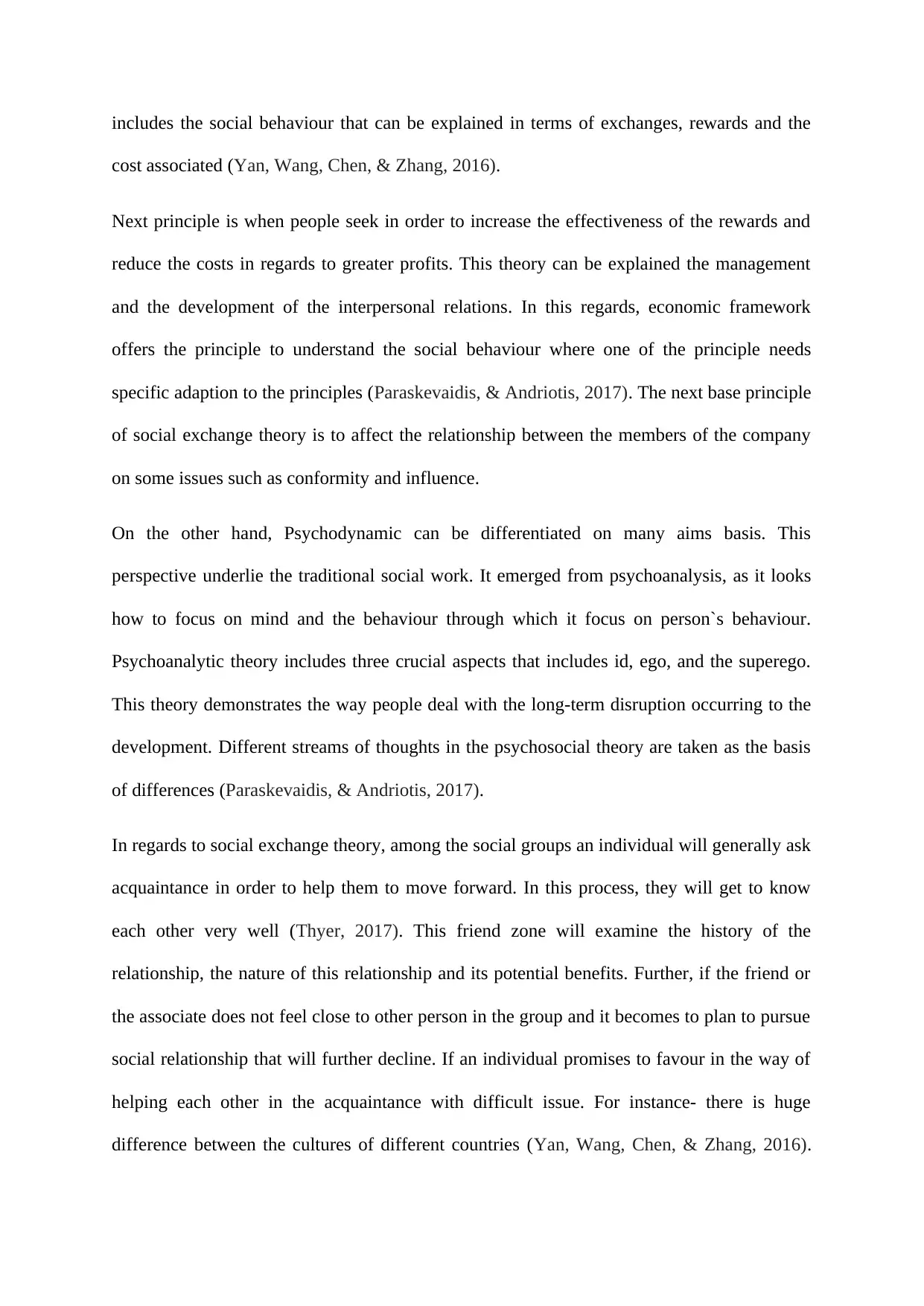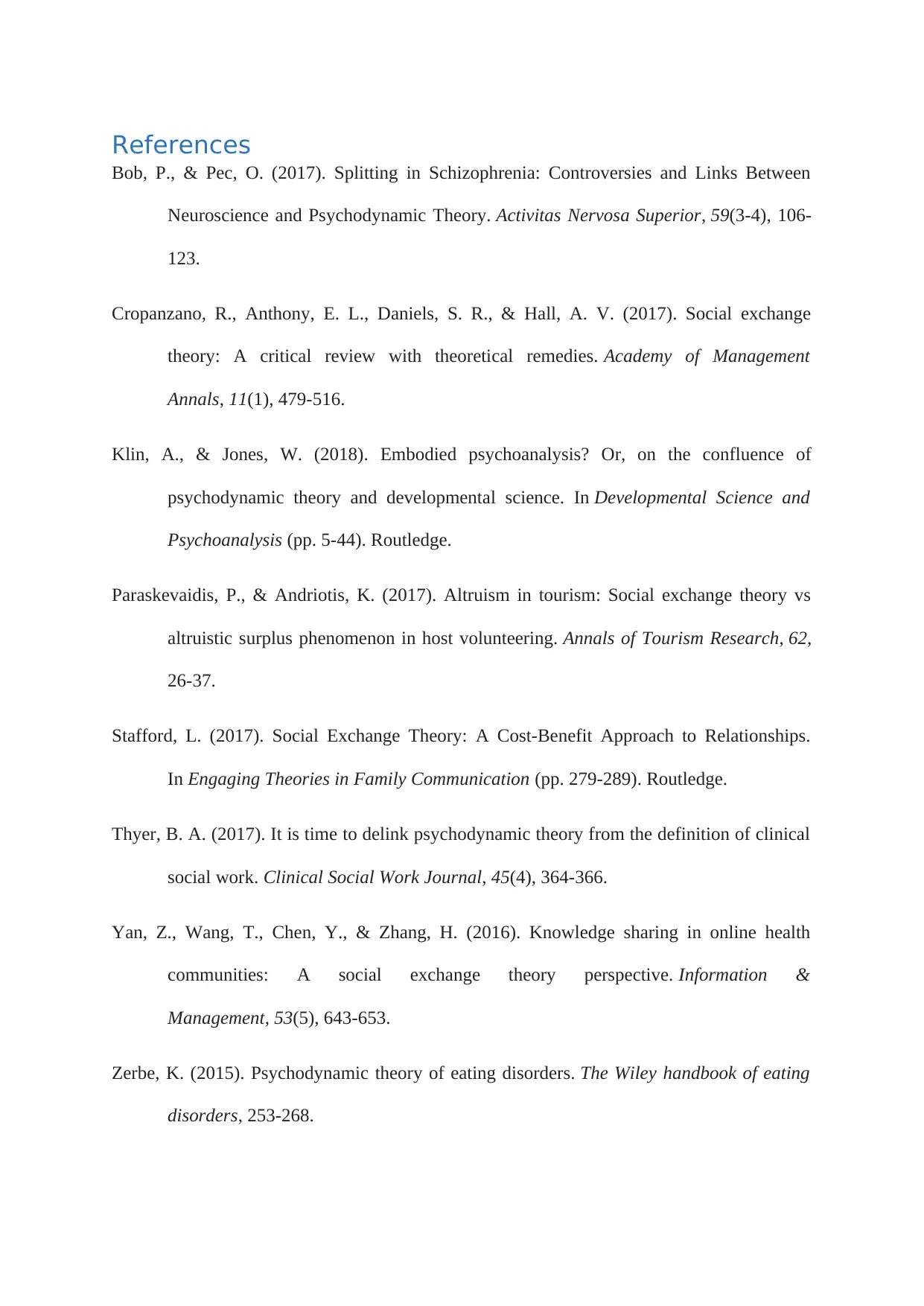Comparing Psychodynamic and Social Exchange Theories in Group Work
VerifiedAdded on 2022/12/16
|8
|1767
|300
Essay
AI Summary
This essay provides a comprehensive comparison of psychodynamic theory and social exchange theory within the context of community and group work. It begins with an overview of each theory, detailing their core principles and applications. Social exchange theory is examined through its focus on cost-benefit analysis and the rational decision-making of individuals in social interactions, including rewards and punishments. Psychodynamic theory is explored for its emphasis on individual behavior, internal emotions, and the influence of past experiences on present actions within a group setting. The essay then highlights the similarities and differences between the two theories, discussing how they approach understanding human behavior in groups. The analysis includes the application of these theories to real-world scenarios and identifies any gaps that may exist between them. The essay concludes by summarizing the key findings and their implications for group work practice, with references to scholarly articles to support the arguments presented.

GROUP WORK
Paraphrase This Document
Need a fresh take? Get an instant paraphrase of this document with our AI Paraphraser

Contents
Introduction...........................................................................................................................................2
Social exchange theory and psychodynamic theory..............................................................................2
Conclusion.............................................................................................................................................5
References.............................................................................................................................................6
Introduction...........................................................................................................................................2
Social exchange theory and psychodynamic theory..............................................................................2
Conclusion.............................................................................................................................................5
References.............................................................................................................................................6

Introduction
This essay brings out a discussion on how community and group work is influenced by
psychodynamic theory and the social exchange theory. This essay establishes a suitable
difference on the both the theories and define what are the core differences in this subject
line. The first paragraph describes the overview of social exchange theory and second
belongs to psychodynamic theory. Lastly, the report discussion shows the use and application
of this theory on social groups and works. It also includes the gap that occurs between both
the theories.
Social exchange theory and psychodynamic theory
Social exchange theory is a psychological concept, which undertakes to study the social
behaviour of people through interaction between two parties, which establish cost benefit
analysis in order to determine benefits. This theory includes economic relationship which
occur when both parties values the goods which the each other have. This theory interprets
the society as a series of numerous interactions between a person or more than two people,
which are based on rewards, and punishments (Yan, Wang, Chen, & Zhang, 2016). Most
interestingly, this theory of social exchange is not a unified and a standardised theory. Rather,
there are different types of behavioural theories that modify the entire framework. All the
viewpoints agree on the basis of basic assumptions in regards to human. For instance- a
person generally seek for rewards, avoid punishments, and are rational. This theory is
associated with the human interaction and the exchange which is a result driven by the social
behaviour. The fundamental theory is related with cost and the rewards, which means cost
and rewards comparison as driven by human behaviour and decisions. It is important to know
that cost are negative outcome of any decision such as money, time, and energy. Whereas,
rewards are the positive outcome of the social exchange procedures. Undoubtedly, people
This essay brings out a discussion on how community and group work is influenced by
psychodynamic theory and the social exchange theory. This essay establishes a suitable
difference on the both the theories and define what are the core differences in this subject
line. The first paragraph describes the overview of social exchange theory and second
belongs to psychodynamic theory. Lastly, the report discussion shows the use and application
of this theory on social groups and works. It also includes the gap that occurs between both
the theories.
Social exchange theory and psychodynamic theory
Social exchange theory is a psychological concept, which undertakes to study the social
behaviour of people through interaction between two parties, which establish cost benefit
analysis in order to determine benefits. This theory includes economic relationship which
occur when both parties values the goods which the each other have. This theory interprets
the society as a series of numerous interactions between a person or more than two people,
which are based on rewards, and punishments (Yan, Wang, Chen, & Zhang, 2016). Most
interestingly, this theory of social exchange is not a unified and a standardised theory. Rather,
there are different types of behavioural theories that modify the entire framework. All the
viewpoints agree on the basis of basic assumptions in regards to human. For instance- a
person generally seek for rewards, avoid punishments, and are rational. This theory is
associated with the human interaction and the exchange which is a result driven by the social
behaviour. The fundamental theory is related with cost and the rewards, which means cost
and rewards comparison as driven by human behaviour and decisions. It is important to know
that cost are negative outcome of any decision such as money, time, and energy. Whereas,
rewards are the positive outcome of the social exchange procedures. Undoubtedly, people
⊘ This is a preview!⊘
Do you want full access?
Subscribe today to unlock all pages.

Trusted by 1+ million students worldwide

will generally accept the idea that will subtract the cost and add through rewards so that they
can calculate the nominal value (Stafford, 2017).
Psychodynamic perspective in relation to social work directly focus on individual behaviour
of a human and its unique way of affecting the internal emotions and further drives to shape
the behaviour of an individual (Stafford, 2017). This deals to respect the views of human
being in order to help them to create a sense of expectations and stresses. This idea has a rich
fund ideas in order to practise and emphasize the significance of person`s emotions and
internal issues and finally deriving the solution the problem. This theory understands the
issues of the people`s life that starts from stemming that how social interaction and
psychological concepts associates with the attachment, object relations and relational
theories. It demonstrates how solution based objectives with the help of social work by
supporting the existing social order in order to help people in adjusting with the society
around. This term mainly signifies inadequate issues earlier in life and further leading it to
aggression, love and anger. Coping is the ability in order to manage issues without being in
anxiety (Yan, Wang, Chen, & Zhang, 2016).
Difference between both the theories defines two different approaches to react in the society
and implications are also different. Social exchange theory includes the social behaviour that
includes the social exchange where people started getting motivated in order to attain the
valued reward for which they will forfeit the value. This theory indicates to seek for the
profits in the social exchange in terms rewards that is much larger than the cost. People often
get disturbed when there is no equity in exchange when others are rewarded that is much
more than the same cost incurred. Some of important elements of this theory are rewards,
value of the reward, social rewards, costs, and the profits, equity and justice on the basis of
distribution, and social exchange. It comprises of several guiding principle. These principles
can calculate the nominal value (Stafford, 2017).
Psychodynamic perspective in relation to social work directly focus on individual behaviour
of a human and its unique way of affecting the internal emotions and further drives to shape
the behaviour of an individual (Stafford, 2017). This deals to respect the views of human
being in order to help them to create a sense of expectations and stresses. This idea has a rich
fund ideas in order to practise and emphasize the significance of person`s emotions and
internal issues and finally deriving the solution the problem. This theory understands the
issues of the people`s life that starts from stemming that how social interaction and
psychological concepts associates with the attachment, object relations and relational
theories. It demonstrates how solution based objectives with the help of social work by
supporting the existing social order in order to help people in adjusting with the society
around. This term mainly signifies inadequate issues earlier in life and further leading it to
aggression, love and anger. Coping is the ability in order to manage issues without being in
anxiety (Yan, Wang, Chen, & Zhang, 2016).
Difference between both the theories defines two different approaches to react in the society
and implications are also different. Social exchange theory includes the social behaviour that
includes the social exchange where people started getting motivated in order to attain the
valued reward for which they will forfeit the value. This theory indicates to seek for the
profits in the social exchange in terms rewards that is much larger than the cost. People often
get disturbed when there is no equity in exchange when others are rewarded that is much
more than the same cost incurred. Some of important elements of this theory are rewards,
value of the reward, social rewards, costs, and the profits, equity and justice on the basis of
distribution, and social exchange. It comprises of several guiding principle. These principles
Paraphrase This Document
Need a fresh take? Get an instant paraphrase of this document with our AI Paraphraser

includes the social behaviour that can be explained in terms of exchanges, rewards and the
cost associated (Yan, Wang, Chen, & Zhang, 2016).
Next principle is when people seek in order to increase the effectiveness of the rewards and
reduce the costs in regards to greater profits. This theory can be explained the management
and the development of the interpersonal relations. In this regards, economic framework
offers the principle to understand the social behaviour where one of the principle needs
specific adaption to the principles (Paraskevaidis, & Andriotis, 2017). The next base principle
of social exchange theory is to affect the relationship between the members of the company
on some issues such as conformity and influence.
On the other hand, Psychodynamic can be differentiated on many aims basis. This
perspective underlie the traditional social work. It emerged from psychoanalysis, as it looks
how to focus on mind and the behaviour through which it focus on person`s behaviour.
Psychoanalytic theory includes three crucial aspects that includes id, ego, and the superego.
This theory demonstrates the way people deal with the long-term disruption occurring to the
development. Different streams of thoughts in the psychosocial theory are taken as the basis
of differences (Paraskevaidis, & Andriotis, 2017).
In regards to social exchange theory, among the social groups an individual will generally ask
acquaintance in order to help them to move forward. In this process, they will get to know
each other very well (Thyer, 2017). This friend zone will examine the history of the
relationship, the nature of this relationship and its potential benefits. Further, if the friend or
the associate does not feel close to other person in the group and it becomes to plan to pursue
social relationship that will further decline. If an individual promises to favour in the way of
helping each other in the acquaintance with difficult issue. For instance- there is huge
difference between the cultures of different countries (Yan, Wang, Chen, & Zhang, 2016).
cost associated (Yan, Wang, Chen, & Zhang, 2016).
Next principle is when people seek in order to increase the effectiveness of the rewards and
reduce the costs in regards to greater profits. This theory can be explained the management
and the development of the interpersonal relations. In this regards, economic framework
offers the principle to understand the social behaviour where one of the principle needs
specific adaption to the principles (Paraskevaidis, & Andriotis, 2017). The next base principle
of social exchange theory is to affect the relationship between the members of the company
on some issues such as conformity and influence.
On the other hand, Psychodynamic can be differentiated on many aims basis. This
perspective underlie the traditional social work. It emerged from psychoanalysis, as it looks
how to focus on mind and the behaviour through which it focus on person`s behaviour.
Psychoanalytic theory includes three crucial aspects that includes id, ego, and the superego.
This theory demonstrates the way people deal with the long-term disruption occurring to the
development. Different streams of thoughts in the psychosocial theory are taken as the basis
of differences (Paraskevaidis, & Andriotis, 2017).
In regards to social exchange theory, among the social groups an individual will generally ask
acquaintance in order to help them to move forward. In this process, they will get to know
each other very well (Thyer, 2017). This friend zone will examine the history of the
relationship, the nature of this relationship and its potential benefits. Further, if the friend or
the associate does not feel close to other person in the group and it becomes to plan to pursue
social relationship that will further decline. If an individual promises to favour in the way of
helping each other in the acquaintance with difficult issue. For instance- there is huge
difference between the cultures of different countries (Yan, Wang, Chen, & Zhang, 2016).

The societies often are includes cultural values in the organisational process. Asian cultures
have a collective form of cultures where it would emphasize more on harmony and sacrifice
for a group. Individual costs are not related to cost; it is just a behaviour that includes
personal freedom, which is not important as the culture of a human. Whereas, in Asian
societies negative cost is related to social disapprovals (Cropanzano, Anthony, Daniels, &
Hall, 2017).
Psychodynamic group as well as the residential care illustrates psychodynamic theory. In
regards to certain examples, it is based on theoretical developments. Initially, some of the
schools use planned theory environment for the young people who suffer from behavioural
and emotional disorders (Zerbe, 2015). Secondly, this therapy is used as American concept
where people are based on psychodynamic group work in order to maladjusted with the
younger generation. This theory includes several issues, which are based on determinism and
the individualism where the emotions are drived in the unique where internal emotions
enhances the behaviour of an individual (Bob, & Pec, 2017). This theory may also create
barriers in changing the practise of the theories focusing on present as well as the future. This
theory fails to incorporate the main social issues, which affect the practise. It includes a range
of interventions that limits and suggests limited concern and a social reform (Klin, & Jones,
2018).
Conclusion
On the basis of discussion carried above, it is seen that psychodynamic theory and the social
exchange theory affects the individual behaviour while performing in the social groups.
Social exchange theory understands the human interaction and undertakes decision-making.
This theory has the application of real world examples in order to understand the
interpersonal relations. On the other hand, psychodynamic theory is a roadmap to harness the
power of relationships, which can empower and motivate others for a positive change.
have a collective form of cultures where it would emphasize more on harmony and sacrifice
for a group. Individual costs are not related to cost; it is just a behaviour that includes
personal freedom, which is not important as the culture of a human. Whereas, in Asian
societies negative cost is related to social disapprovals (Cropanzano, Anthony, Daniels, &
Hall, 2017).
Psychodynamic group as well as the residential care illustrates psychodynamic theory. In
regards to certain examples, it is based on theoretical developments. Initially, some of the
schools use planned theory environment for the young people who suffer from behavioural
and emotional disorders (Zerbe, 2015). Secondly, this therapy is used as American concept
where people are based on psychodynamic group work in order to maladjusted with the
younger generation. This theory includes several issues, which are based on determinism and
the individualism where the emotions are drived in the unique where internal emotions
enhances the behaviour of an individual (Bob, & Pec, 2017). This theory may also create
barriers in changing the practise of the theories focusing on present as well as the future. This
theory fails to incorporate the main social issues, which affect the practise. It includes a range
of interventions that limits and suggests limited concern and a social reform (Klin, & Jones,
2018).
Conclusion
On the basis of discussion carried above, it is seen that psychodynamic theory and the social
exchange theory affects the individual behaviour while performing in the social groups.
Social exchange theory understands the human interaction and undertakes decision-making.
This theory has the application of real world examples in order to understand the
interpersonal relations. On the other hand, psychodynamic theory is a roadmap to harness the
power of relationships, which can empower and motivate others for a positive change.
⊘ This is a preview!⊘
Do you want full access?
Subscribe today to unlock all pages.

Trusted by 1+ million students worldwide

Paraphrase This Document
Need a fresh take? Get an instant paraphrase of this document with our AI Paraphraser

References
Bob, P., & Pec, O. (2017). Splitting in Schizophrenia: Controversies and Links Between
Neuroscience and Psychodynamic Theory. Activitas Nervosa Superior, 59(3-4), 106-
123.
Cropanzano, R., Anthony, E. L., Daniels, S. R., & Hall, A. V. (2017). Social exchange
theory: A critical review with theoretical remedies. Academy of Management
Annals, 11(1), 479-516.
Klin, A., & Jones, W. (2018). Embodied psychoanalysis? Or, on the confluence of
psychodynamic theory and developmental science. In Developmental Science and
Psychoanalysis (pp. 5-44). Routledge.
Paraskevaidis, P., & Andriotis, K. (2017). Altruism in tourism: Social exchange theory vs
altruistic surplus phenomenon in host volunteering. Annals of Tourism Research, 62,
26-37.
Stafford, L. (2017). Social Exchange Theory: A Cost-Benefit Approach to Relationships.
In Engaging Theories in Family Communication (pp. 279-289). Routledge.
Thyer, B. A. (2017). It is time to delink psychodynamic theory from the definition of clinical
social work. Clinical Social Work Journal, 45(4), 364-366.
Yan, Z., Wang, T., Chen, Y., & Zhang, H. (2016). Knowledge sharing in online health
communities: A social exchange theory perspective. Information &
Management, 53(5), 643-653.
Zerbe, K. (2015). Psychodynamic theory of eating disorders. The Wiley handbook of eating
disorders, 253-268.
Bob, P., & Pec, O. (2017). Splitting in Schizophrenia: Controversies and Links Between
Neuroscience and Psychodynamic Theory. Activitas Nervosa Superior, 59(3-4), 106-
123.
Cropanzano, R., Anthony, E. L., Daniels, S. R., & Hall, A. V. (2017). Social exchange
theory: A critical review with theoretical remedies. Academy of Management
Annals, 11(1), 479-516.
Klin, A., & Jones, W. (2018). Embodied psychoanalysis? Or, on the confluence of
psychodynamic theory and developmental science. In Developmental Science and
Psychoanalysis (pp. 5-44). Routledge.
Paraskevaidis, P., & Andriotis, K. (2017). Altruism in tourism: Social exchange theory vs
altruistic surplus phenomenon in host volunteering. Annals of Tourism Research, 62,
26-37.
Stafford, L. (2017). Social Exchange Theory: A Cost-Benefit Approach to Relationships.
In Engaging Theories in Family Communication (pp. 279-289). Routledge.
Thyer, B. A. (2017). It is time to delink psychodynamic theory from the definition of clinical
social work. Clinical Social Work Journal, 45(4), 364-366.
Yan, Z., Wang, T., Chen, Y., & Zhang, H. (2016). Knowledge sharing in online health
communities: A social exchange theory perspective. Information &
Management, 53(5), 643-653.
Zerbe, K. (2015). Psychodynamic theory of eating disorders. The Wiley handbook of eating
disorders, 253-268.
1 out of 8
Related Documents
Your All-in-One AI-Powered Toolkit for Academic Success.
+13062052269
info@desklib.com
Available 24*7 on WhatsApp / Email
![[object Object]](/_next/static/media/star-bottom.7253800d.svg)
Unlock your academic potential
Copyright © 2020–2025 A2Z Services. All Rights Reserved. Developed and managed by ZUCOL.




